Detailed Analysis and Design of Car Airbag Deployment System
VerifiedAdded on 2023/06/07
|11
|2154
|319
Report
AI Summary
This report provides a comprehensive analysis of a car airbag deployment system. It begins with an introduction to airbags and their function in automotive safety, followed by a detailed schematic circuit diagram illustrating the system's components and their interconnections, including sensors, the control unit, and the airbag module. The report then delves into the manufacturing process of airbags, covering the production of propellants, inflator assembly, and the airbag itself, along with the final module assembly. Furthermore, the report includes a discussion on how the design can be improved, such as by using more advanced sensors, integrated systems, and improved coatings. The report concludes with a summary of the system's functionality and the critical role of the electronic control unit in the deployment decision, highlighting the importance of rapid and accurate deployment for occupant safety. This report is contributed by a student and is available on Desklib, a platform offering AI-based study tools.

Car Air Bag Deployment System 1
CAR AIR BAG DEPLOYMENT SYSTEM
A Research Paper on Airbag By
Student’s Name
Name of the Professor
Institutional Affiliation
City/State
Year/Month/Day
CAR AIR BAG DEPLOYMENT SYSTEM
A Research Paper on Airbag By
Student’s Name
Name of the Professor
Institutional Affiliation
City/State
Year/Month/Day
Paraphrase This Document
Need a fresh take? Get an instant paraphrase of this document with our AI Paraphraser

Car Air Bag Deployment System 2
Table of Contents
INTRODUCTION...........................................................................................................................................3
SCHEMATIC CIRCUIT DIAGRAM FOR THE AIR BAG SYSTEM.........................................................................4
THE MANUFACTURING PROCESS.................................................................................................................6
HOW THE DESIGN CAN BE IMPROVED........................................................................................................8
CONCLUSION...............................................................................................................................................9
BIBLIOGRAPHY...........................................................................................................................................10
Table of Contents
INTRODUCTION...........................................................................................................................................3
SCHEMATIC CIRCUIT DIAGRAM FOR THE AIR BAG SYSTEM.........................................................................4
THE MANUFACTURING PROCESS.................................................................................................................6
HOW THE DESIGN CAN BE IMPROVED........................................................................................................8
CONCLUSION...............................................................................................................................................9
BIBLIOGRAPHY...........................................................................................................................................10
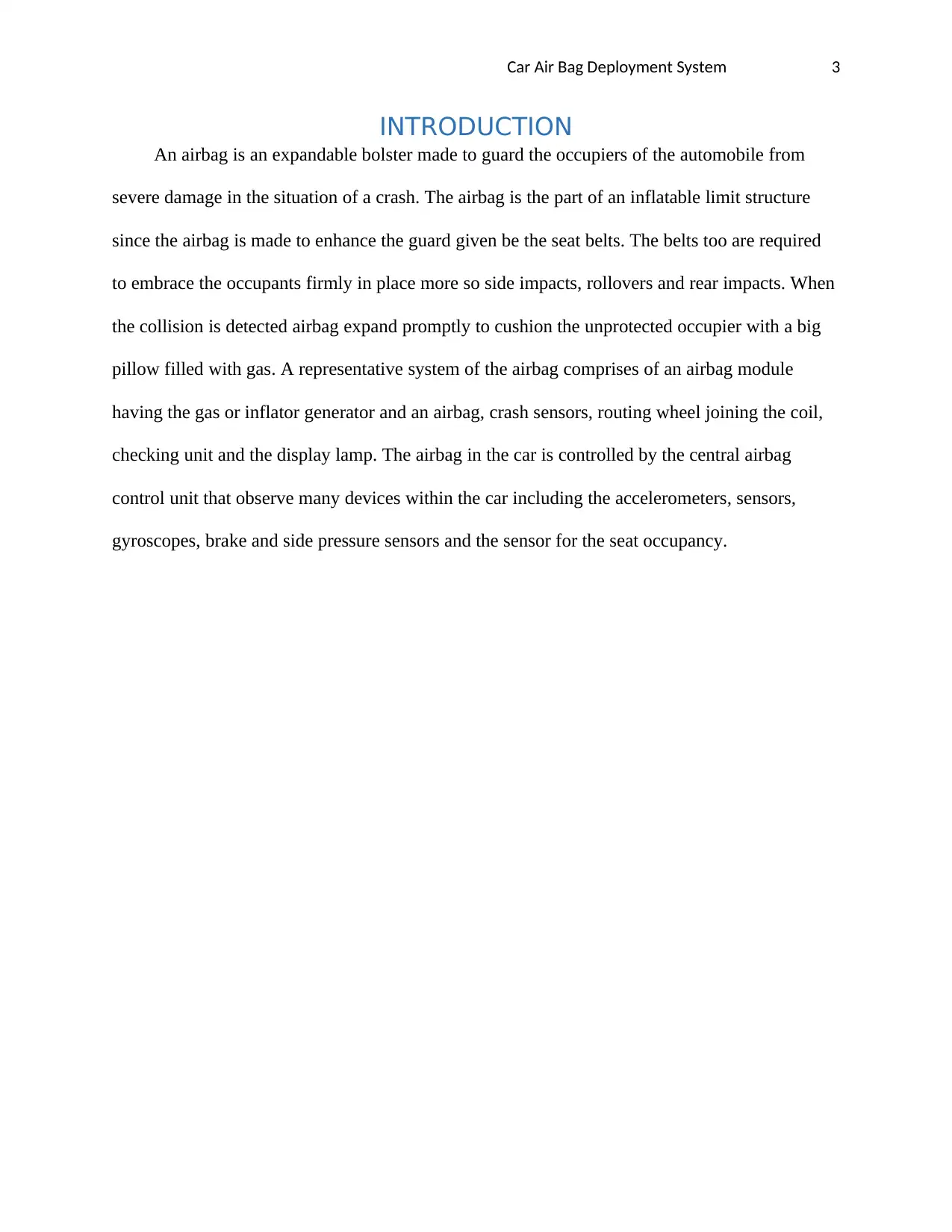
Car Air Bag Deployment System 3
INTRODUCTION
An airbag is an expandable bolster made to guard the occupiers of the automobile from
severe damage in the situation of a crash. The airbag is the part of an inflatable limit structure
since the airbag is made to enhance the guard given be the seat belts. The belts too are required
to embrace the occupants firmly in place more so side impacts, rollovers and rear impacts. When
the collision is detected airbag expand promptly to cushion the unprotected occupier with a big
pillow filled with gas. A representative system of the airbag comprises of an airbag module
having the gas or inflator generator and an airbag, crash sensors, routing wheel joining the coil,
checking unit and the display lamp. The airbag in the car is controlled by the central airbag
control unit that observe many devices within the car including the accelerometers, sensors,
gyroscopes, brake and side pressure sensors and the sensor for the seat occupancy.
INTRODUCTION
An airbag is an expandable bolster made to guard the occupiers of the automobile from
severe damage in the situation of a crash. The airbag is the part of an inflatable limit structure
since the airbag is made to enhance the guard given be the seat belts. The belts too are required
to embrace the occupants firmly in place more so side impacts, rollovers and rear impacts. When
the collision is detected airbag expand promptly to cushion the unprotected occupier with a big
pillow filled with gas. A representative system of the airbag comprises of an airbag module
having the gas or inflator generator and an airbag, crash sensors, routing wheel joining the coil,
checking unit and the display lamp. The airbag in the car is controlled by the central airbag
control unit that observe many devices within the car including the accelerometers, sensors,
gyroscopes, brake and side pressure sensors and the sensor for the seat occupancy.
⊘ This is a preview!⊘
Do you want full access?
Subscribe today to unlock all pages.

Trusted by 1+ million students worldwide
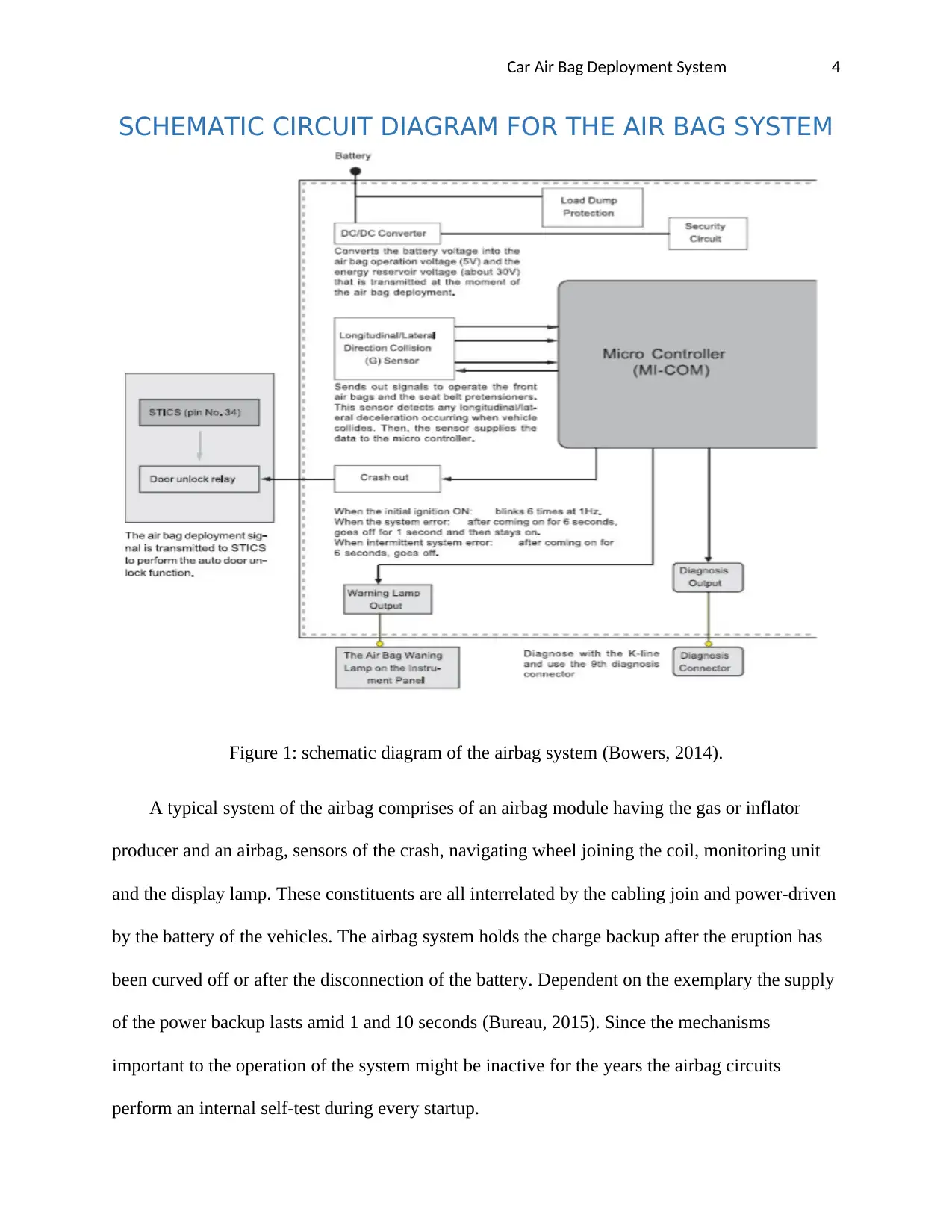
Car Air Bag Deployment System 4
SCHEMATIC CIRCUIT DIAGRAM FOR THE AIR BAG SYSTEM
Figure 1: schematic diagram of the airbag system (Bowers, 2014).
A typical system of the airbag comprises of an airbag module having the gas or inflator
producer and an airbag, sensors of the crash, navigating wheel joining the coil, monitoring unit
and the display lamp. These constituents are all interrelated by the cabling join and power-driven
by the battery of the vehicles. The airbag system holds the charge backup after the eruption has
been curved off or after the disconnection of the battery. Dependent on the exemplary the supply
of the power backup lasts amid 1 and 10 seconds (Bureau, 2015). Since the mechanisms
important to the operation of the system might be inactive for the years the airbag circuits
perform an internal self-test during every startup.
SCHEMATIC CIRCUIT DIAGRAM FOR THE AIR BAG SYSTEM
Figure 1: schematic diagram of the airbag system (Bowers, 2014).
A typical system of the airbag comprises of an airbag module having the gas or inflator
producer and an airbag, sensors of the crash, navigating wheel joining the coil, monitoring unit
and the display lamp. These constituents are all interrelated by the cabling join and power-driven
by the battery of the vehicles. The airbag system holds the charge backup after the eruption has
been curved off or after the disconnection of the battery. Dependent on the exemplary the supply
of the power backup lasts amid 1 and 10 seconds (Bureau, 2015). Since the mechanisms
important to the operation of the system might be inactive for the years the airbag circuits
perform an internal self-test during every startup.
Paraphrase This Document
Need a fresh take? Get an instant paraphrase of this document with our AI Paraphraser
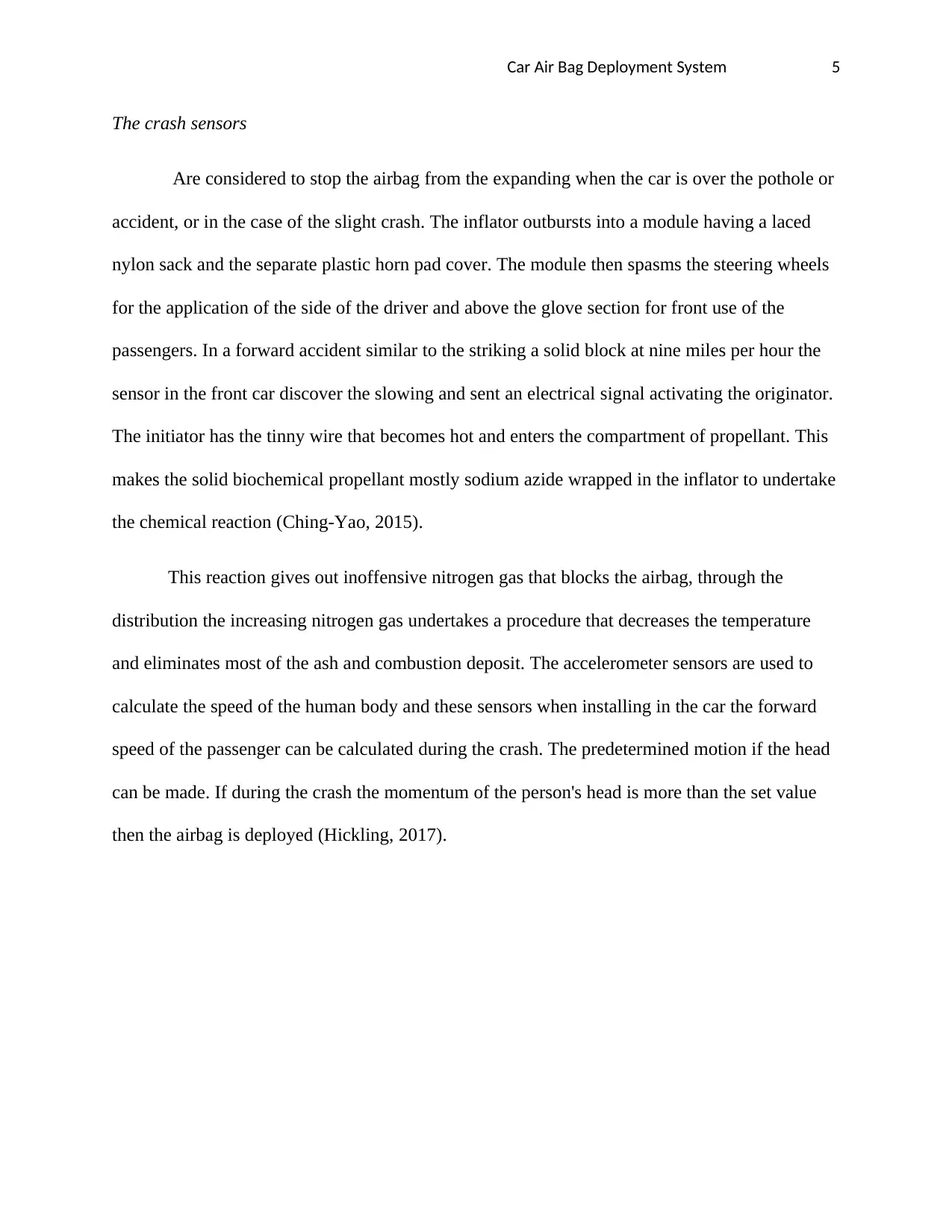
Car Air Bag Deployment System 5
The crash sensors
Are considered to stop the airbag from the expanding when the car is over the pothole or
accident, or in the case of the slight crash. The inflator outbursts into a module having a laced
nylon sack and the separate plastic horn pad cover. The module then spasms the steering wheels
for the application of the side of the driver and above the glove section for front use of the
passengers. In a forward accident similar to the striking a solid block at nine miles per hour the
sensor in the front car discover the slowing and sent an electrical signal activating the originator.
The initiator has the tinny wire that becomes hot and enters the compartment of propellant. This
makes the solid biochemical propellant mostly sodium azide wrapped in the inflator to undertake
the chemical reaction (Ching-Yao, 2015).
This reaction gives out inoffensive nitrogen gas that blocks the airbag, through the
distribution the increasing nitrogen gas undertakes a procedure that decreases the temperature
and eliminates most of the ash and combustion deposit. The accelerometer sensors are used to
calculate the speed of the human body and these sensors when installing in the car the forward
speed of the passenger can be calculated during the crash. The predetermined motion if the head
can be made. If during the crash the momentum of the person's head is more than the set value
then the airbag is deployed (Hickling, 2017).
The crash sensors
Are considered to stop the airbag from the expanding when the car is over the pothole or
accident, or in the case of the slight crash. The inflator outbursts into a module having a laced
nylon sack and the separate plastic horn pad cover. The module then spasms the steering wheels
for the application of the side of the driver and above the glove section for front use of the
passengers. In a forward accident similar to the striking a solid block at nine miles per hour the
sensor in the front car discover the slowing and sent an electrical signal activating the originator.
The initiator has the tinny wire that becomes hot and enters the compartment of propellant. This
makes the solid biochemical propellant mostly sodium azide wrapped in the inflator to undertake
the chemical reaction (Ching-Yao, 2015).
This reaction gives out inoffensive nitrogen gas that blocks the airbag, through the
distribution the increasing nitrogen gas undertakes a procedure that decreases the temperature
and eliminates most of the ash and combustion deposit. The accelerometer sensors are used to
calculate the speed of the human body and these sensors when installing in the car the forward
speed of the passenger can be calculated during the crash. The predetermined motion if the head
can be made. If during the crash the momentum of the person's head is more than the set value
then the airbag is deployed (Hickling, 2017).
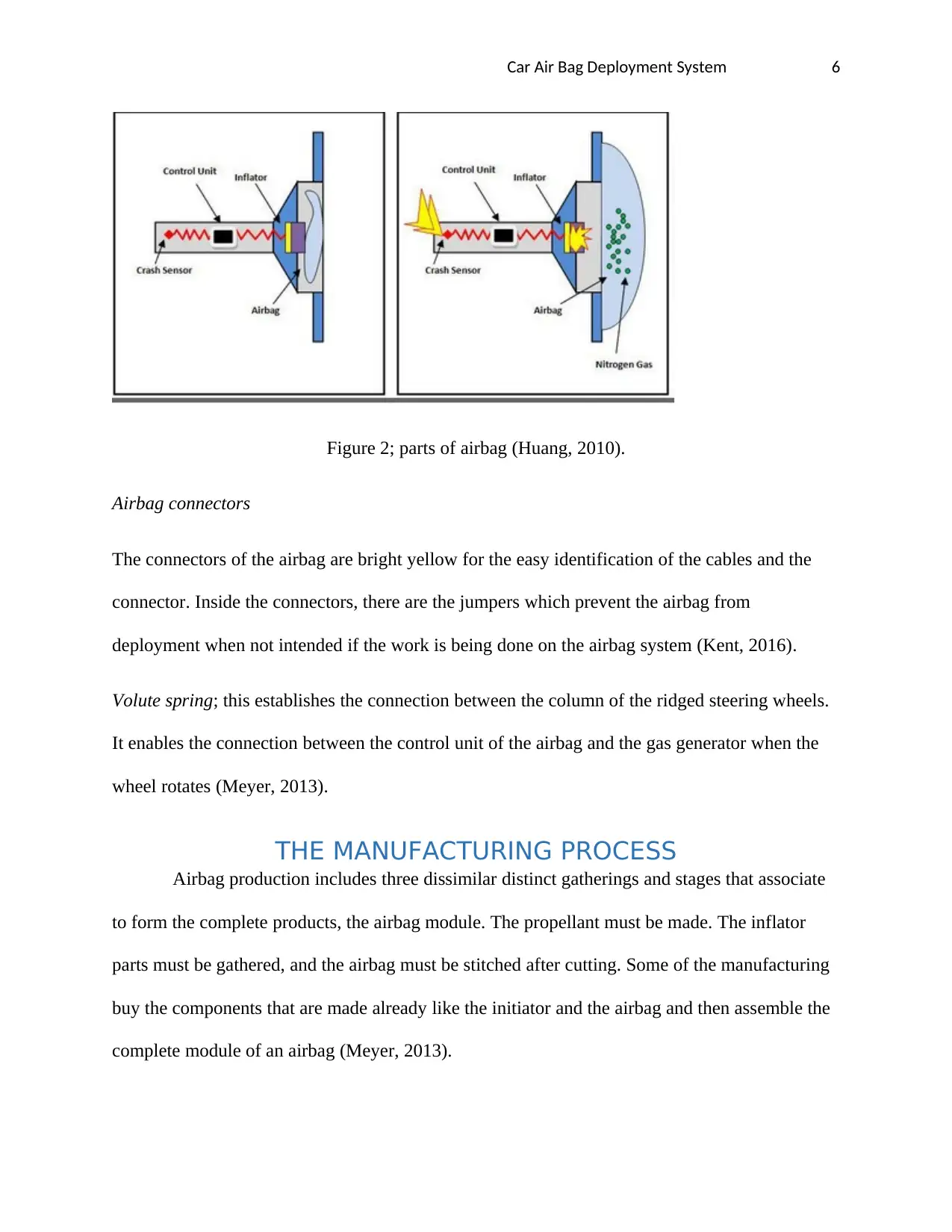
Car Air Bag Deployment System 6
Figure 2; parts of airbag (Huang, 2010).
Airbag connectors
The connectors of the airbag are bright yellow for the easy identification of the cables and the
connector. Inside the connectors, there are the jumpers which prevent the airbag from
deployment when not intended if the work is being done on the airbag system (Kent, 2016).
Volute spring; this establishes the connection between the column of the ridged steering wheels.
It enables the connection between the control unit of the airbag and the gas generator when the
wheel rotates (Meyer, 2013).
THE MANUFACTURING PROCESS
Airbag production includes three dissimilar distinct gatherings and stages that associate
to form the complete products, the airbag module. The propellant must be made. The inflator
parts must be gathered, and the airbag must be stitched after cutting. Some of the manufacturing
buy the components that are made already like the initiator and the airbag and then assemble the
complete module of an airbag (Meyer, 2013).
Figure 2; parts of airbag (Huang, 2010).
Airbag connectors
The connectors of the airbag are bright yellow for the easy identification of the cables and the
connector. Inside the connectors, there are the jumpers which prevent the airbag from
deployment when not intended if the work is being done on the airbag system (Kent, 2016).
Volute spring; this establishes the connection between the column of the ridged steering wheels.
It enables the connection between the control unit of the airbag and the gas generator when the
wheel rotates (Meyer, 2013).
THE MANUFACTURING PROCESS
Airbag production includes three dissimilar distinct gatherings and stages that associate
to form the complete products, the airbag module. The propellant must be made. The inflator
parts must be gathered, and the airbag must be stitched after cutting. Some of the manufacturing
buy the components that are made already like the initiator and the airbag and then assemble the
complete module of an airbag (Meyer, 2013).
⊘ This is a preview!⊘
Do you want full access?
Subscribe today to unlock all pages.

Trusted by 1+ million students worldwide

Car Air Bag Deployment System 7
Propellant; it consist of the sodium azide assorted with an oxidizer material that helps the burn
the azide of sodium when kindled and received from the vendor and checked to make sure it
follows the necessities. After the check, it is put in a good place for storing until required. Also
they oxidizer is taken from the vendors outside, inspected and stored. From the storage, the
oxidizer and sodium azide is then blended carefully under the sophisticated process control that
is computerized. Because of the blasts possibilities, the processing residue takes place in the
secluded bunkers. In the event, the safe sensors detect the sparks. Deluge systems of high speed
will douse the room with water. After the blending. The mixture of propellant is sent to the
storage and presses are used to bandage the propellant combination into the disk form (Ribbens,
2013).
inflator assembly; the components of inflator like the canister, mesh of wire without stains with
the ceramic material inside, filter assembly and the originator are taken from vendors and
checked. The constituents are collected on the high fabrication line that is automatic. The inflator
sub-assembly is added to the propellant and originator to form the assembly of an initiator. Laser
welding using the carbon dioxide gas is used to connect stainless steel inflator sub-assemblies.
while the friction inertial connecting is used to join inflator of aluminum sub-assembly laser
welding uses the beam, to assembles the parts together while inertia friction soldering is just the
rubbing the 2 metals until the surfaces are hot to connect together (Sorensen, 2014).
Airbag; the interlaced nylon airbag is taken from dealers and checked for any defect in the
material. The airbag textile is die cut to good shapes and stitched, externally and internally to
connect the 2 sides properly. After the sewing the airbag, it is inflated and checked for any
imperfections seam (Speckert, 2013).
Propellant; it consist of the sodium azide assorted with an oxidizer material that helps the burn
the azide of sodium when kindled and received from the vendor and checked to make sure it
follows the necessities. After the check, it is put in a good place for storing until required. Also
they oxidizer is taken from the vendors outside, inspected and stored. From the storage, the
oxidizer and sodium azide is then blended carefully under the sophisticated process control that
is computerized. Because of the blasts possibilities, the processing residue takes place in the
secluded bunkers. In the event, the safe sensors detect the sparks. Deluge systems of high speed
will douse the room with water. After the blending. The mixture of propellant is sent to the
storage and presses are used to bandage the propellant combination into the disk form (Ribbens,
2013).
inflator assembly; the components of inflator like the canister, mesh of wire without stains with
the ceramic material inside, filter assembly and the originator are taken from vendors and
checked. The constituents are collected on the high fabrication line that is automatic. The inflator
sub-assembly is added to the propellant and originator to form the assembly of an initiator. Laser
welding using the carbon dioxide gas is used to connect stainless steel inflator sub-assemblies.
while the friction inertial connecting is used to join inflator of aluminum sub-assembly laser
welding uses the beam, to assembles the parts together while inertia friction soldering is just the
rubbing the 2 metals until the surfaces are hot to connect together (Sorensen, 2014).
Airbag; the interlaced nylon airbag is taken from dealers and checked for any defect in the
material. The airbag textile is die cut to good shapes and stitched, externally and internally to
connect the 2 sides properly. After the sewing the airbag, it is inflated and checked for any
imperfections seam (Speckert, 2013).
Paraphrase This Document
Need a fresh take? Get an instant paraphrase of this document with our AI Paraphraser
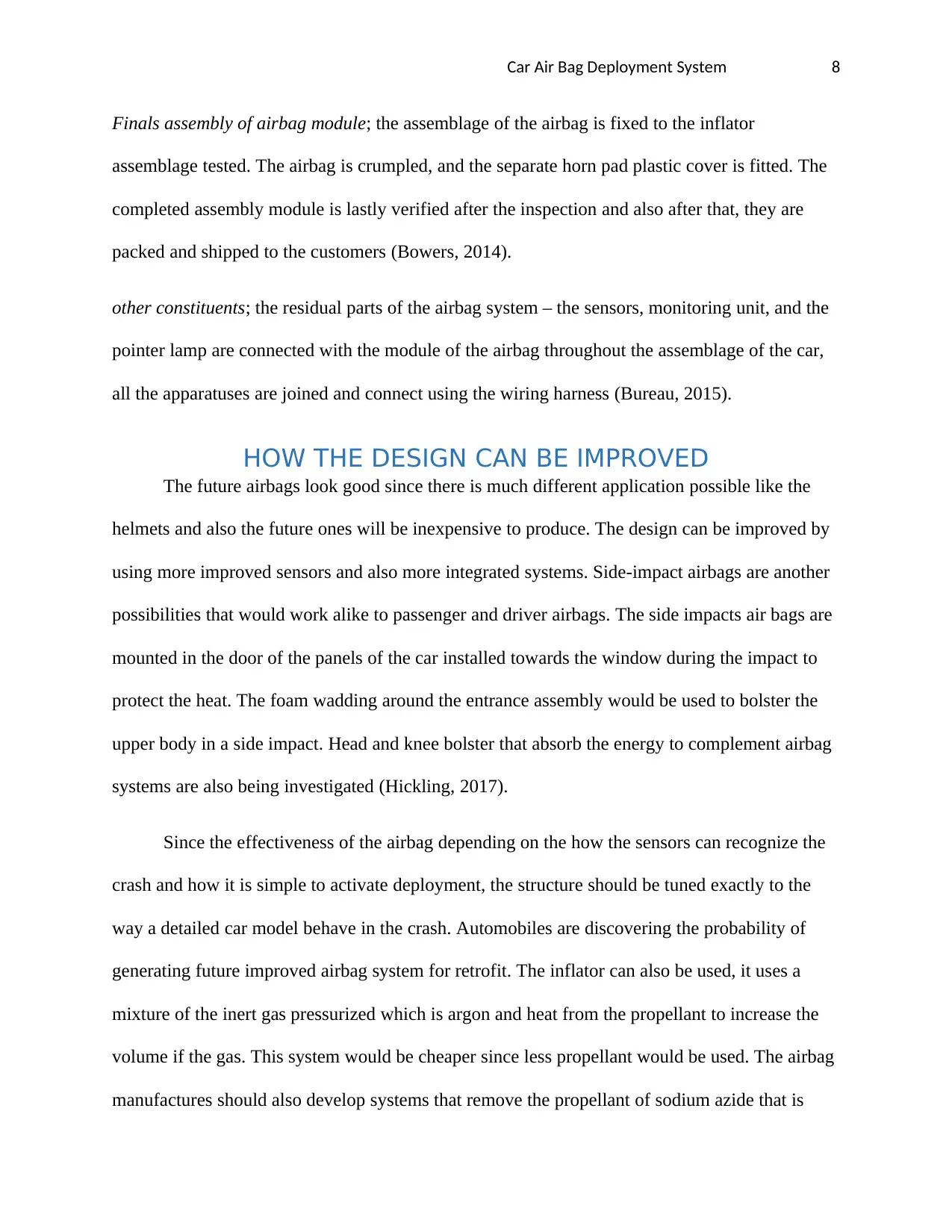
Car Air Bag Deployment System 8
Finals assembly of airbag module; the assemblage of the airbag is fixed to the inflator
assemblage tested. The airbag is crumpled, and the separate horn pad plastic cover is fitted. The
completed assembly module is lastly verified after the inspection and also after that, they are
packed and shipped to the customers (Bowers, 2014).
other constituents; the residual parts of the airbag system – the sensors, monitoring unit, and the
pointer lamp are connected with the module of the airbag throughout the assemblage of the car,
all the apparatuses are joined and connect using the wiring harness (Bureau, 2015).
HOW THE DESIGN CAN BE IMPROVED
The future airbags look good since there is much different application possible like the
helmets and also the future ones will be inexpensive to produce. The design can be improved by
using more improved sensors and also more integrated systems. Side-impact airbags are another
possibilities that would work alike to passenger and driver airbags. The side impacts air bags are
mounted in the door of the panels of the car installed towards the window during the impact to
protect the heat. The foam wadding around the entrance assembly would be used to bolster the
upper body in a side impact. Head and knee bolster that absorb the energy to complement airbag
systems are also being investigated (Hickling, 2017).
Since the effectiveness of the airbag depending on the how the sensors can recognize the
crash and how it is simple to activate deployment, the structure should be tuned exactly to the
way a detailed car model behave in the crash. Automobiles are discovering the probability of
generating future improved airbag system for retrofit. The inflator can also be used, it uses a
mixture of the inert gas pressurized which is argon and heat from the propellant to increase the
volume if the gas. This system would be cheaper since less propellant would be used. The airbag
manufactures should also develop systems that remove the propellant of sodium azide that is
Finals assembly of airbag module; the assemblage of the airbag is fixed to the inflator
assemblage tested. The airbag is crumpled, and the separate horn pad plastic cover is fitted. The
completed assembly module is lastly verified after the inspection and also after that, they are
packed and shipped to the customers (Bowers, 2014).
other constituents; the residual parts of the airbag system – the sensors, monitoring unit, and the
pointer lamp are connected with the module of the airbag throughout the assemblage of the car,
all the apparatuses are joined and connect using the wiring harness (Bureau, 2015).
HOW THE DESIGN CAN BE IMPROVED
The future airbags look good since there is much different application possible like the
helmets and also the future ones will be inexpensive to produce. The design can be improved by
using more improved sensors and also more integrated systems. Side-impact airbags are another
possibilities that would work alike to passenger and driver airbags. The side impacts air bags are
mounted in the door of the panels of the car installed towards the window during the impact to
protect the heat. The foam wadding around the entrance assembly would be used to bolster the
upper body in a side impact. Head and knee bolster that absorb the energy to complement airbag
systems are also being investigated (Hickling, 2017).
Since the effectiveness of the airbag depending on the how the sensors can recognize the
crash and how it is simple to activate deployment, the structure should be tuned exactly to the
way a detailed car model behave in the crash. Automobiles are discovering the probability of
generating future improved airbag system for retrofit. The inflator can also be used, it uses a
mixture of the inert gas pressurized which is argon and heat from the propellant to increase the
volume if the gas. This system would be cheaper since less propellant would be used. The airbag
manufactures should also develop systems that remove the propellant of sodium azide that is
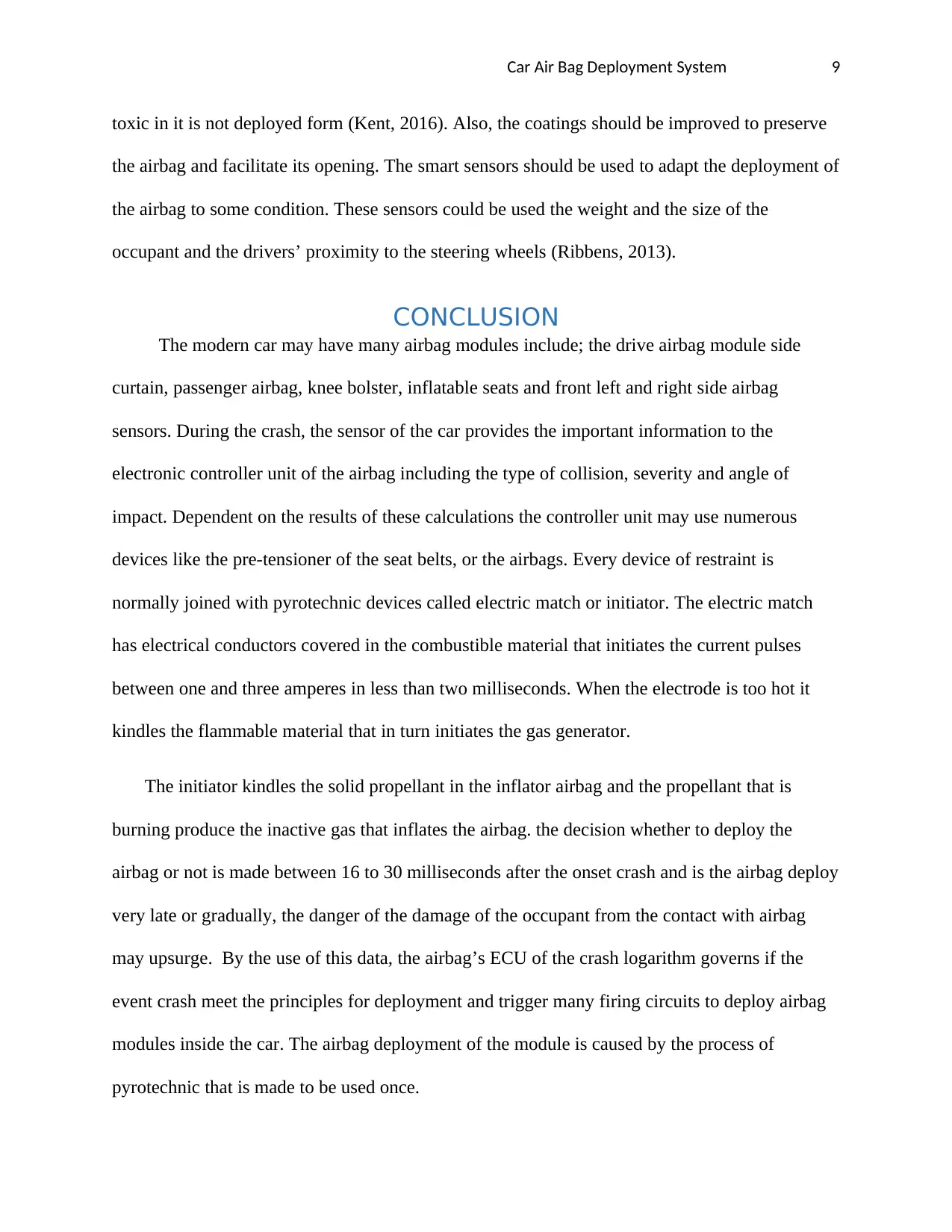
Car Air Bag Deployment System 9
toxic in it is not deployed form (Kent, 2016). Also, the coatings should be improved to preserve
the airbag and facilitate its opening. The smart sensors should be used to adapt the deployment of
the airbag to some condition. These sensors could be used the weight and the size of the
occupant and the drivers’ proximity to the steering wheels (Ribbens, 2013).
CONCLUSION
The modern car may have many airbag modules include; the drive airbag module side
curtain, passenger airbag, knee bolster, inflatable seats and front left and right side airbag
sensors. During the crash, the sensor of the car provides the important information to the
electronic controller unit of the airbag including the type of collision, severity and angle of
impact. Dependent on the results of these calculations the controller unit may use numerous
devices like the pre-tensioner of the seat belts, or the airbags. Every device of restraint is
normally joined with pyrotechnic devices called electric match or initiator. The electric match
has electrical conductors covered in the combustible material that initiates the current pulses
between one and three amperes in less than two milliseconds. When the electrode is too hot it
kindles the flammable material that in turn initiates the gas generator.
The initiator kindles the solid propellant in the inflator airbag and the propellant that is
burning produce the inactive gas that inflates the airbag. the decision whether to deploy the
airbag or not is made between 16 to 30 milliseconds after the onset crash and is the airbag deploy
very late or gradually, the danger of the damage of the occupant from the contact with airbag
may upsurge. By the use of this data, the airbag’s ECU of the crash logarithm governs if the
event crash meet the principles for deployment and trigger many firing circuits to deploy airbag
modules inside the car. The airbag deployment of the module is caused by the process of
pyrotechnic that is made to be used once.
toxic in it is not deployed form (Kent, 2016). Also, the coatings should be improved to preserve
the airbag and facilitate its opening. The smart sensors should be used to adapt the deployment of
the airbag to some condition. These sensors could be used the weight and the size of the
occupant and the drivers’ proximity to the steering wheels (Ribbens, 2013).
CONCLUSION
The modern car may have many airbag modules include; the drive airbag module side
curtain, passenger airbag, knee bolster, inflatable seats and front left and right side airbag
sensors. During the crash, the sensor of the car provides the important information to the
electronic controller unit of the airbag including the type of collision, severity and angle of
impact. Dependent on the results of these calculations the controller unit may use numerous
devices like the pre-tensioner of the seat belts, or the airbags. Every device of restraint is
normally joined with pyrotechnic devices called electric match or initiator. The electric match
has electrical conductors covered in the combustible material that initiates the current pulses
between one and three amperes in less than two milliseconds. When the electrode is too hot it
kindles the flammable material that in turn initiates the gas generator.
The initiator kindles the solid propellant in the inflator airbag and the propellant that is
burning produce the inactive gas that inflates the airbag. the decision whether to deploy the
airbag or not is made between 16 to 30 milliseconds after the onset crash and is the airbag deploy
very late or gradually, the danger of the damage of the occupant from the contact with airbag
may upsurge. By the use of this data, the airbag’s ECU of the crash logarithm governs if the
event crash meet the principles for deployment and trigger many firing circuits to deploy airbag
modules inside the car. The airbag deployment of the module is caused by the process of
pyrotechnic that is made to be used once.
⊘ This is a preview!⊘
Do you want full access?
Subscribe today to unlock all pages.

Trusted by 1+ million students worldwide
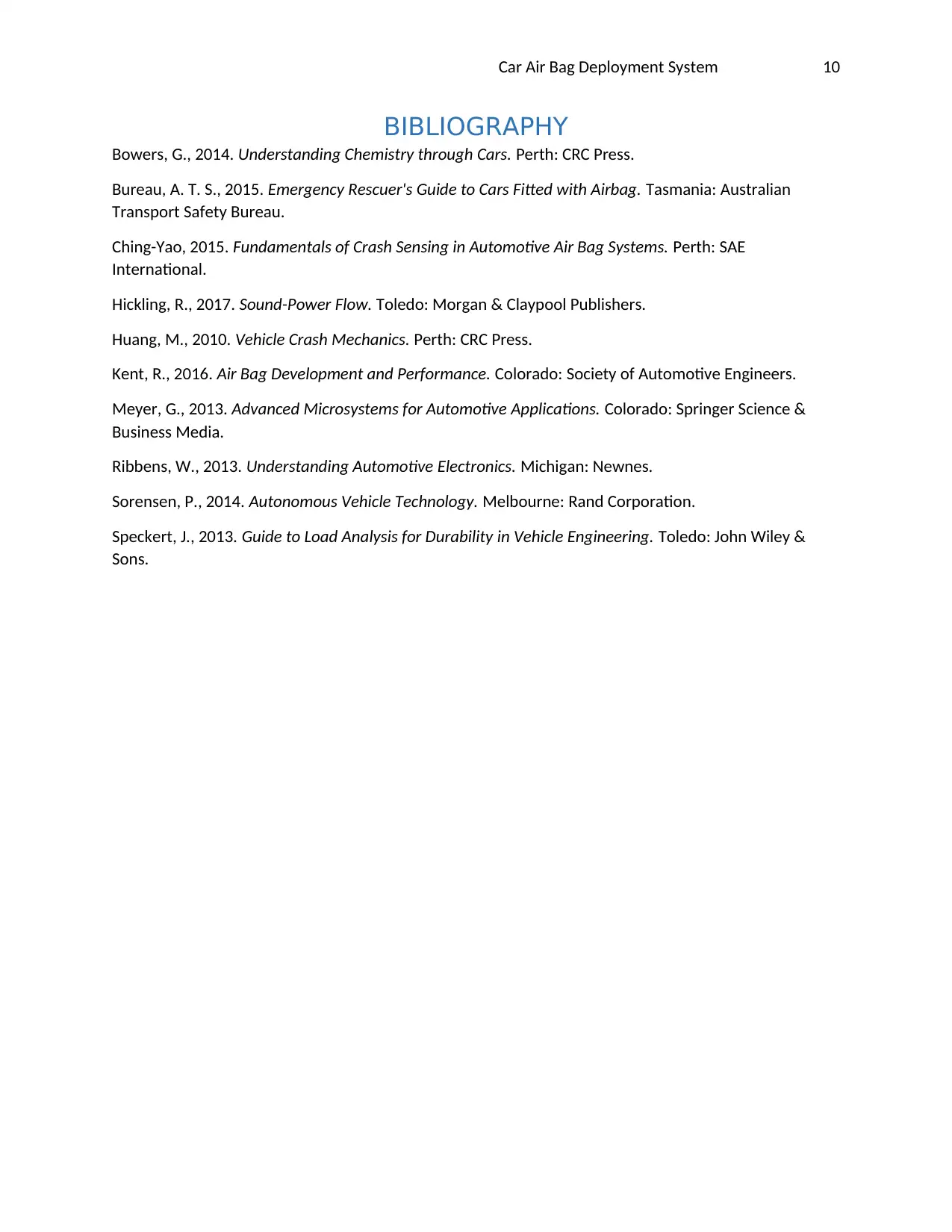
Car Air Bag Deployment System 10
BIBLIOGRAPHY
Bowers, G., 2014. Understanding Chemistry through Cars. Perth: CRC Press.
Bureau, A. T. S., 2015. Emergency Rescuer's Guide to Cars Fitted with Airbag. Tasmania: Australian
Transport Safety Bureau.
Ching-Yao, 2015. Fundamentals of Crash Sensing in Automotive Air Bag Systems. Perth: SAE
International.
Hickling, R., 2017. Sound-Power Flow. Toledo: Morgan & Claypool Publishers.
Huang, M., 2010. Vehicle Crash Mechanics. Perth: CRC Press.
Kent, R., 2016. Air Bag Development and Performance. Colorado: Society of Automotive Engineers.
Meyer, G., 2013. Advanced Microsystems for Automotive Applications. Colorado: Springer Science &
Business Media.
Ribbens, W., 2013. Understanding Automotive Electronics. Michigan: Newnes.
Sorensen, P., 2014. Autonomous Vehicle Technology. Melbourne: Rand Corporation.
Speckert, J., 2013. Guide to Load Analysis for Durability in Vehicle Engineering. Toledo: John Wiley &
Sons.
BIBLIOGRAPHY
Bowers, G., 2014. Understanding Chemistry through Cars. Perth: CRC Press.
Bureau, A. T. S., 2015. Emergency Rescuer's Guide to Cars Fitted with Airbag. Tasmania: Australian
Transport Safety Bureau.
Ching-Yao, 2015. Fundamentals of Crash Sensing in Automotive Air Bag Systems. Perth: SAE
International.
Hickling, R., 2017. Sound-Power Flow. Toledo: Morgan & Claypool Publishers.
Huang, M., 2010. Vehicle Crash Mechanics. Perth: CRC Press.
Kent, R., 2016. Air Bag Development and Performance. Colorado: Society of Automotive Engineers.
Meyer, G., 2013. Advanced Microsystems for Automotive Applications. Colorado: Springer Science &
Business Media.
Ribbens, W., 2013. Understanding Automotive Electronics. Michigan: Newnes.
Sorensen, P., 2014. Autonomous Vehicle Technology. Melbourne: Rand Corporation.
Speckert, J., 2013. Guide to Load Analysis for Durability in Vehicle Engineering. Toledo: John Wiley &
Sons.
Paraphrase This Document
Need a fresh take? Get an instant paraphrase of this document with our AI Paraphraser

Car Air Bag Deployment System 11
1 out of 11
Your All-in-One AI-Powered Toolkit for Academic Success.
+13062052269
info@desklib.com
Available 24*7 on WhatsApp / Email
![[object Object]](/_next/static/media/star-bottom.7253800d.svg)
Unlock your academic potential
Copyright © 2020–2025 A2Z Services. All Rights Reserved. Developed and managed by ZUCOL.